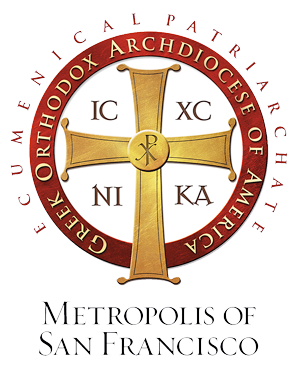The worship services of the Orthodox Church are liturgical. Liturgical worship makes mystically present the earthly life and work of our Lord Jesus Christ. It is through our worship that we obey the Lord’s command to ‘Do this in remembrance of me’. Not only do we remember God in our services, we ask for His grace and His mercy, that we might be united with Him in a communion of love. The unification of man with God, sometimes called ‘deification’ or ‘Theosis’, is the purpose of all of our worship services.
The Divine Liturgy
The central worship service of the Orthodox Church is called the Divine Liturgy (meaning ‘The Divine Work’). The Divine Liturgy is a Eucharistic service and contains two main parts: the Liturgy of the Catechumens, sometimes called the Liturgy of the Word, at which the Scriptures are proclaimed and expounded, and the Liturgy of the Faithful, sometimes called the Liturgy of the Eucharist, in which the gifts of bread and wine are offered and consecrated. The Church teaches that these gifts, in a mystical manner, truly become the body and blood of Jesus Christ. The Lord says, ‘unless you eat the flesh of the son of man and drink his blood, you have no life in you; he who eats my flesh and drinks my blood has eternal life, and I will raise him up at the last day’ (Jn 6:53-54). Thus the Orthodox Church has the Eucharist at the center of Her worship.
While the Divine Liturgy is the central worship service of the Church, and is served every Sunday, the Church has an entire daily cycle of services, which begin at sunset and are served at their appointed hour until sunset on the following day, when the cycle begins all over again with the evening service of Vespers.
The Clergy
Worship services in the Orthodox Church are celebrated by a priest, a man who has been called upon by his community and set-apart for special service to the Church. Each priest is ordained, through the laying on of hands, by a bishop. Each bishop has Apostolic succession–an unbroken line of ordination and common faith, extending back the Apostles themselves. The priest is the servant of his community, and serves with the blessing of his respective bishop.
Traditional Elements of Worship
The Orthodox Church has always made use of vestments, candles, incense, and icons in worship. This is in part due to the rich liturgical heritage that the early Christians received from the Jewish rites of worship in the Temple. The inside of an Orthodox church is to be, in as much as is possible, a reflection of the heavenly temple. Our worship is to be, in every way possible, a reflection of heavenly worship–which was witnessed by the Prophet Isaiah, the Apostle Paul, and others. For this reason, an Orthodox priest will be clothed in rich-colored vestments, candles will adorn the altar and iconostasis, and the air will be permeated by the sweet smell of incense. All of these things are meant to draw our minds upwards, away from the cares of this life, so that we may focus on Christ and the life that is to come.


